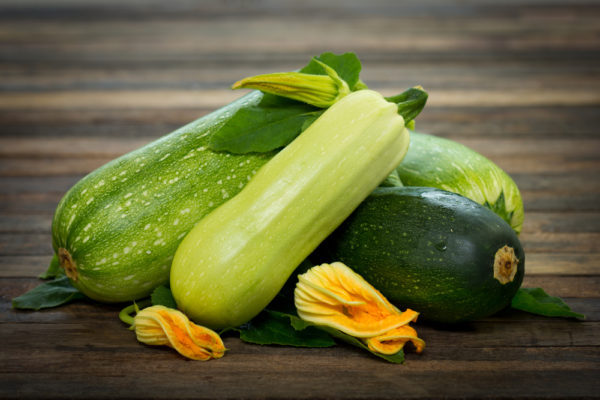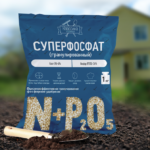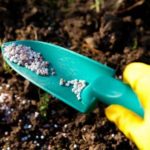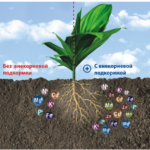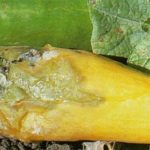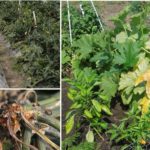This early-ripening crop bears fruit throughout the summer. The plant is unpretentious, but requires care. Planting and cultivation is carried out on open ridges, for early harvest, seedlings are planted in greenhouses. In this article, we will look at how to properly plant a zucchini in open ground, as well as how to care for it at home and how to feed it during the whole growing season.
Table of contents
The timing of planting zucchini seeds in open ground
To plant seeds in the ground, start when the soil warms up to +12 degrees, not earlier than mid-May. In the cold earth, the seeds will not germinate, rot and die. Therefore, the landing is left to warmer weather. With late night frosts, tender sprouts freeze. Planting zucchini seeds for seedlings is carried out at will, as the fruits have time to ripen and planted immediately seeds on the depth of the soil.
You can do this in early May (for the middle band) by pre-spilling the hole with warm water. Place of sowing cover plastic 5-liter transparent canister with a cut neck. It turns out a mini greenhouse for each plant. Do not forget that planting vegetables in the ground and in a greenhouse or greenhouse significantly different.
After the onset of sustained heat and the absence of night frost, the canister is removed and you can grow seeds further
Proper preparation of beds and planting seed at home
Best cooking ridges in the fall. When digging bring rotten manure or compost, the full complex of fertilizers - superphosphate, potash salt, ammonium nitrate. Ate needed pre lime.
Where and which side to plant the seeds? Squashes can be sown on compost heaps. A loose, humus-rich land is a good place for this culture.
The bed prepared in autumn is enough to loosen and make holes in it. The bush at the zucchini is volumetric; it is planted at a distance of 0.5-0.8 meters. Seeds are treated with a 1% solution of potassium permanganate, ash or nitroammofoski, having sustained for 20 minutes. Then washed with water. This will protect the seeds from diseases and ensure a friendly germination.
2-3 seeds are placed in the hole, in case one does not rise. At emergence of shoots, leave one sapling, the others pinch off.

Care during the growing season
Zucchini loves heat and moisture. In dry weather, water is watered once a week, not colder than 22 degrees. With a massive growth of fruits - every three days. Under each plant poured up to two liters of water. Before cleaning, do not water, so as not to suffer taste.
A large bush and large fruits require a lot of nutrition. Fertilizers begin to make after the appearance of these leaves and continue the entire period of fruiting. Fertilizers are well applied in liquid form. Most of all he loves organic. Foliar dressing has a positive effect on vegetable development. Spraying a bush every 10 days with a solution of fertilizer, you can significantly increase the yield.
Weeds are dangerous only until it grows, in the future, they simply will not be able to develop under a spreading crown.
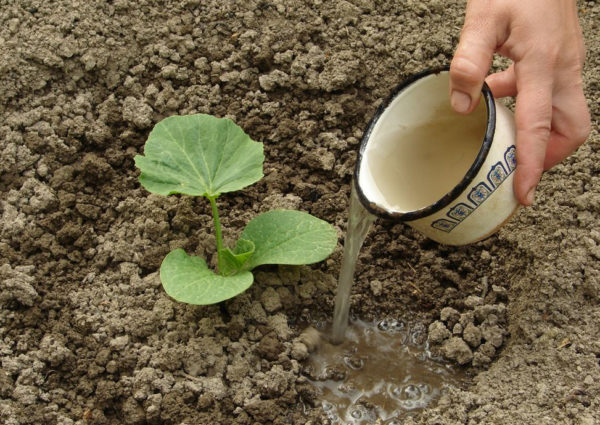
What can feed and fertilize zucchini?
What fertilizers are used for the plant, list them:
- Mineral
- Organic
- Fertilizers from improvised means.
Mineral fertilizers
For the development of this culture uses a full complex fertilizer in the following composition: 1 tbsp. spoon of potassium sulfate, double superphosphate, urea is dissolved in 10 liters of water. After complete dissolution, water under the root system of 1.5 liters per plant.
Nitrogen cause the growth of green mass of the plant. Apply in the spring and summer. Closer to autumn, their use is undesirable.These are urea, ammonium, calcium and sodium nitrate, ammonium sulfate.
Phosphoric help fruits ripen faster, reduce the growing season. These are superphosphate, double superphosphate, phosphoric flour.
- Superphosphate granular fertilizers for feeding zucchini
- Granular superphosphate to be added to the soil
- Soil pattern before and after fertilizer addition
Potash increase the resistance of plants to lack of moisture and heat. Increase resistance to diseases and pests. There are potassium sulfate, potassium chloride, potassium salts.
Magnesium and iron containing include magnesium oxide, boron, iron. Increase the yield of fruits and their quality. Magnesium helps deoxidize the soil. It is better to fertilize in the fall according to a specific scheme, indicated in the instructions.
Microadditives are very important for plant development: boric, molybdenum, manganese, copper.They require a small amount, add to the complex.

Organic Fertilizer
Organics - an important component in the nutrition of zucchini. They consist of the main elements - nitrogen, phosphorus, potassium, trace elements, vitamins. All this is easily digested. So feed zucchini can be at any time.
Manure. Organics of animal origin. Not very nutritious feeding. Improves soil structure. The simultaneous application of mineral fertilizers and manure improves the absorption of mineral.
Humus. Dead manure Improves the condition and composition of the soil. Digest after making a bush in a short time.
Compost. It turns out after decomposition of vegetable and kitchen waste. Its maturation lasts at least three years. Used for feeding, mulching.
Bird droppings. It contains all the necessary components, the most valuable manure fertilizer. It takes time to be prepared to make a culture. Fresh, corrosive, can burn roots and leaves.
Peat. Makes soil easier, nourishes. Not every peat is useful. Sour peat is used in composts.
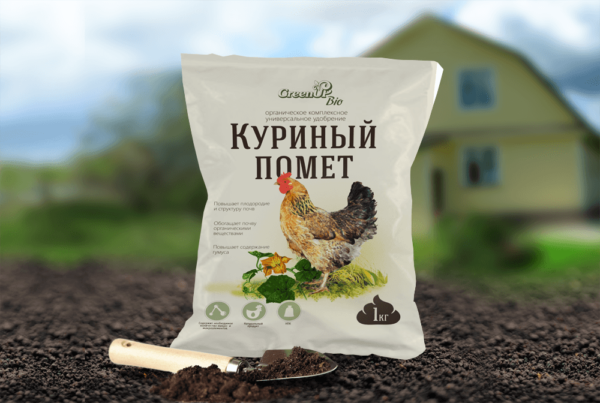
Other organic fertilizers and top dressing
For food use grass and leaves, yeast, ash, food waste.
Green grass, especially nettle, is soaked in a barrel of water, kept for 10-15 days, and get a herbal infusion. Strain it and get a fertilizer that is easily digested in a quick time.
Green grass supplement is obtained by digging and embedding in the ground, grown in the garden sideratov.
People infusion of wood ash contains many trace elements, reduces the acidity of the soil. Does not contain nitrogen, it should be added.
Pests and control of them
Squashes are subject to such diseases:
- White rot
- Gray rot.
- Mealy dew.
- Fusarium wilt.
White and gray rot covers leaves, stalks and ovaries with bloom, they soften and dry out. This is a fungus. Appears in cold wet weather in dense plantings. Disputes persist in the ground. To destroy the disease spray copper sulphate, sulfuric zinc, urea solution. Do not thicken the landing, watered with warm water.
Mealy dew. The leaves are first affected, then the disease damages the whole plant. Absorbs plant nutrition, reduces yield. Distributed with fluctuations in temperature, excess nitrogen. It is treated by spraying colloidal sulfur, manure infusion, a solution of potassium permanganate.
Fusarium wilt affects the roots. With further development goes to the stem, and it dies. You can destroy only completely replacing the soil.
All these diseases are stored on plant residues and in the soil. It is possible to prevent their occurrence by thoroughly preparing the ridges, burning plant residues, post-harvest processing, and maintaining crop rotation.
- White rot
- Mealy dew
- Gray rot
- Fusarium
Insect pests for zucchini:
- Gourd aphid.
- Spider mite
- Whitefly.
Larvae melon aphid hibernate on the remains of plants, multiply rapidly in spring. Damage the stems and leaves, after which they dry out. Autumn cleaning of ridges, burning of vegetable garbage will help prevent insect invasion. In the summer, the plants are sprayed with the infusion of hot pepper, onion, potato tops, and powdered with tobacco dust.
Spider mite small invisible pest.Populates the bottom of the sheet. Causes leaf spot and their drying out. Control measures such as with aphids.
White fly forms a sticky sugar coating on the back of the leaves. This is the environment for the formation of various fungi and plant diseases. The pest can be washed off with water, not allowing them to remain on the ground afterwards. When a large number of insects, the soil after harvest, treat the insecticide "Commander".
Harvesting and Storage
Green fruits with a length of up to 25 cm are considered the most tasty and useful. They have thin skin and small immature seeds. By removing the zucchini in time, we help the formation and growth of new ovaries. In this case, all summer we will have fresh Zelentsy. From the end of August, we begin to make storage for the winter. We collect fruits with hard skin and a long stalk for better storage. Harvest to frost.
Squashes ripening crop, the first harvest we get in 20 days after flowering. Early harvest, allows you to get fresh vitamins in early summer. The wide possibilities of their use makes zucchini a popular crop among gardeners.
